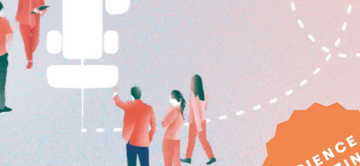This article was published in TSE science magazine, TSE Mag. It is part of the Autumn 2023 issue, dedicated to “The World of Work”. Discover the full PDF here and email us for a printed copy or your feedback on the mag, there.
New technologies can cause huge disruption to jobs and livelihoods. Fearful textile workers in 19th-century England and France – the Luddites and Canuts – responded to industrial innovation with violent protests. Should today’s workers tremble at the rise of artificial intelligence? TSE’s François Poinas argues that AI is likely to have contradictory effects on employment, inequality and education.
Will there still be jobs in the future?
Technological revolutions in the past have always led to job creation and destruction, but never to the end of labor. Given the nature of the current development of AI (around machine learning and associated methods), there is no particular reason to think that this time will be different. AI is more likely to automate specific tasks within a job rather than entire occupations. However, developments in machine learning and associated methods such as deep learning and neural networks will have important consequences for many professions.
For example, in healthcare, machine learning models can be trained to predict the likelihood of a patient succumbing to a particular disease based on their medical history and lifestyle. In finance, algorithms can help to predict stock prices. Such technologies can replace workers in some tasks but, by improving productivity, they can add value that increases demand for labor. AI can also create new tasks where labor has a comparative advantage.
The impact on workers depends on whether the tasks they are performing are a complement or a substitute to AI. Researchers have been classifying jobs according to the likelihood that they can be performed by AI, either using expert opinion (Brynjofson, Mitchell, Rock, 2018), patents (Webb, 2021), or the advancement of AI capabilities (Felten, Raj, Seamans, 2018). This burgeoning literature has not reached a consensus yet about the effect of AI on jobs. The former find no occupation in which all tasks are likely to be replaced by AI, and that both high- and low-skill occupations are at risk, whereas Webb finds that high-skill occupations will be the most affected (figure 7.a).
Will rewarding careers be replaced by precarious, short-term work and poor conditions?
The jobs of the future will be different, with different tasks. Many repetitive and predictable tasks are easy to automate; but tasks that require fine manual dexterity, complex decision-making, creativity, social intelligence, and emotional engagement may be less susceptible to replacement by machines.
AI can replace workers, but it is also a tool that can augment human capabilities and enable workers to focus on higher-value tasks. This can lead to job transformation rather than job loss. For example, AI can be very useful for interpreting X-ray images, allowing radiologists more time to focus on other tasks for which AI is less suitable, such as choosing images, interpreting the machine's results, and combining qualitative information.
The extent to which workers will suffer or benefit from AI depends on whether there is more creation or destruction of jobs, and on the characteristics of the jobs affected (especially in terms of skills). If employment becomes scarce, workers will have less bargaining power to demand good working conditions and wages. These effects will not be uniform across workers if some groups are more affected than others. For instance, if AI replaces more high-skill jobs, driving up competition for lower-skill jobs, this may force formerly well-paid workers to accept worse conditions, part-time work, and short-term contracts.
Will AI increase inequality?
The impact on inequality also depends on how differently skilled groups of workers are affected. In the 80s and 90s, innovations in IT allowed the automation of routine cognitive tasks, so the net effect was a decline in employment in middle-skill groups (white-collar, clerical jobs), and an increase in employment in other groups, contributing to increased wage inequality (see Autor, Dorn, 2013, figure 1.A). If high-skill workers are pushed out of work but other groups are not affected, AI technologies may reduce the existing wage gap.
How can students prepare for an AI-dominated job market?
There will be job opportunities in the AI industry – to develop, train, maintain AI systems – but also in sectors that will use AI as a tool. Workers need to be prepared to work with these AI tools, especially in terms of skill acquisition. Developers also have the possibility to create new tasks and develop new AI tools that do not just replace humans in their work, but augment employment.
Training workers to develop AI products will require skills in optimization, programming, and big data. Training will also need to be adapted for other jobs that are affected by AI as certain tasks are replaced. For example, if buses become increasingly automated, the training of their human operators should focus less on driving and more on other dimensions such as passenger relationships and problem solving.
FURTHER READING
- “Skills, Tasks and Technologies: Implications for Employment and Earnings.” In Handbook of Labor Economics. Vol. 4, Part B, ed. David Card and Orley Ashenfelter, 1043–1171. Daron Acemoglu and David H Autor. 2011.
- Occupational, industry, and geographic exposure to artificial intelligence: A novel dataset and its potential uses, E. Felten, M. Raj, R. Seamans, 2021.
- The Impact of Artificial Intelligence on the Labor Market, M. Webb, 2020.
- What Can Machines Learn, and What Does It Mean for Occupations and the Economy? E. Brynjolfsson, T. Mitchell, and D. Rock, 2018.
- The Growth of Low-Skill Service Jobs and the Polarization of the US Labor Market, D. H. Autor and D. Dorn, 2013.




